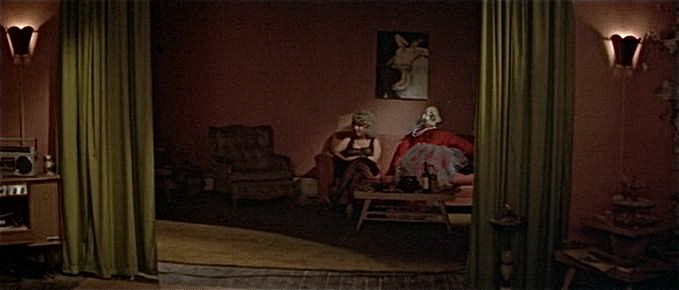 Back to selection
Back to selection
The Blue Velvet Project, #94

Second #4418, 73:38
At Ben’s, at last. The woman, the doll, and the painting above them—framed by the green (velvet?) curtains—telegraph Frank’s entrance. They are a tightly composed grouping in an open frame, whose curtains anticipate the vaudeville show which is about to unfold, complete with Ben’s lip-synched performance of “In Dreams,” some stock violence, and a running gag that features Jeffrey as the butt of a joke he does not understand.
Ben’s apartment is an anarchy of crossed signals and mental jump cuts. The year after Blue Velvet’s release, Robert Coover’s story collection A Night at the Movies, or, You Must Remember This was published. It includes a story, “Lap Dissolves,” that uses the idea of cinematic transitions as an organizing principle at the sentence level, and begins:
She clings to the edge of the cliff, her feet kicking in the wind, the earth breaking away beneath her fingertips. There is a faint roar, as of crashing waves, far below. He struggles against his bonds, chewing at the ropes, throwing himself against the cabin door. She screams as the cliff edge crumbles, a scream swept away by the rushing wind. At last the door splinters and he smashes through, tumbling forward in his bonds, rolling and pitching toward the edge of the cliff. Her hand disappears, then reappears, snatching desperately for a fresh purchase. He staggers to his knees, his feet, plunges ahead, the ropes slipping away like a discarded newspaper as he hails the approaching bus. She lets go, takes the empty seat. Their eyes meet.
There is a continuity of place in Ben’s apartment, but not a continuity of psyche. The tone shape-shifts between horror and menace and the absurd, as if Ben’s place was not of the external world at all, but rather a projection of Frank’s mind. If we are to speak of the perseverance of the image in the digital age (“it is only necessary to copy those numbers accurately . . . in order to produce a ‘clone’ or perfect reproduction of the original, totally free of imperfections,” Leo Enticknap notes in his book Moving Image Technology: From Zoetrope to Digital) then we must also anticipate the beautiful and humane imperfections we bring to the cleansed digital image. The frame at second number 4418 is perfectly reproducible digitally without any generation loss, and yet when we recall the image in our minds, it changes. Perhaps we remember it like this, the image a little rougher, a little brighter:
Over and against the totalitarian perfection of the digital image, we disintegrate. In our minds, the image can never be perfectly recalled. As Fred Madison says in Lost Highway, “I like to remember things my own way. . . . How I remembered them. Not necessarily the way they happened.”
Over the period of one full year — three days per week — The Blue Velvet Project will seize a frame every 47 seconds of David Lynch’s classic to explore. These posts will run until second 7,200 in August 2012. For a complete archive of the project, click here. And here is the introduction to the project.

